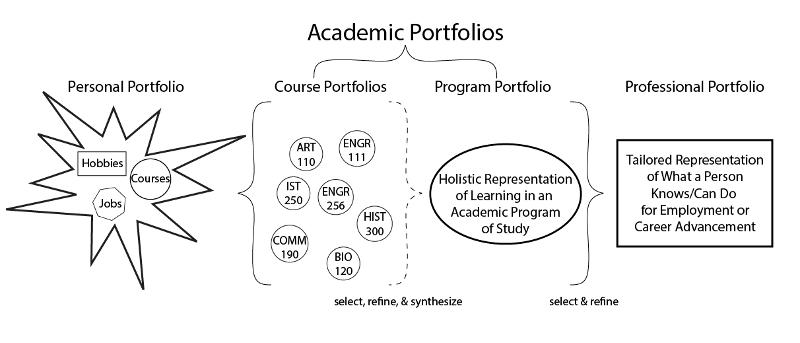Part 1 - What is an ePortfolio?
ePortfolio Definition
All ePortfolios are websites, but not all websites are ePortfolios. ePortfolios are:
- personalized: http://en.wikipedia.org/wiki/Personalized_learning
- active: http://en.wikipedia.org/wiki/Active_learning
- multimodal: http://en.wikipedia.org/wiki/Multimodality
Why are ePortfolios Important?
According to A Vision for Penn State: A Report of the Blue and White Vision Council (2013, p. 14), portfolios are cited as an aspect of "significant technological change" pertinent to Penn State strategy in a digital (r)evolution.
Academic portfolios:
- Support multimodal learning and multimedia expression
- Increase student engagement
- Make learning visible
- Catalyze institutional change
- By supporting a richer view of learning, encouraging a learning-centered institutional conversation, and catalyzing broad institutional change in structure and culture, e-portfolios can help colleges become more integrated and adaptive learning organizations." (Eynon, Gambino, Torok, 2014)
Academic portfolios benefit students by:
- Providing opportunities for more authentic, contextual learning.
- Increasing their engagement with course content.
- Improving skills reflection and meta-cognition.
- Development of self-publishing skills.
Academic portfolios benefit instructors by:
- Enhancing student learning in all of the ways described above.
- Providing a structure which facilitates more frequent (and thus more productive) feedback on student work.
- Allowing them to view evidence of student learning and growth over time (providing greater context and a broader view of student achievement).
- Allows them to teach with technology in new and innovative ways.
- Paperless= more sustainable
Types of ePortfolios
There are several types of ePortfolios, but this tutorial focuses on academic portfolios. Academic ePortfolios are created within a student's course or program of study. Typical characteristics of an academic portfolio include:
- Purpose: support and present learning around a program of study
- Authorship: individual
- Audience: self, peers, instructors, credentialing authorities
- Privacy: semi-private, public
- Formalness: formal
- Motivator: curriculum driven
Academic ePortfolios will include some combination of the following three items:
- Evidence: Show me what you've learned - an artifact of learning. You develop this.
- Reflection: Show me how you think about what you've learned in relation to the evidence. You develop this.
- Assessment: The ongoing conversation and feedback which surrounds the evidence and reflection. Others (usually instructors) provide this.
Other types of portfolios include learning and professional portfolios.
Typical characteristics of a learning portfolio include:
- Purpose: support learning around topics of inquiry
- Authorship: individual, collaborative
- Audience: self, peers, instructors
- Privacy: private, semi-private, public
- Formalness: informal, semi-formal, formal
- Motivator: interest driven
Typical characteristics of a professional portfolio include:
- Purpose: present knowledge, skills, and abilities relevant to emporyment
- Authorship: individual
- Audience: employers, clients, general public
- Privacy: semi-private, public
- Formalness: formal
- Motivator: profession driven
The follwing illustration shows the difference between the three types of portfolios, as well as how one might influence the others.

A personal portfolio might draw upon experiences listed in an academic portfolio. An academic portfolio might consis of a number of course portfolios combined into a holistic program portfolio. A professional portfolio, in tern, might incorporate important items from an academic portfolio.


